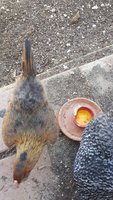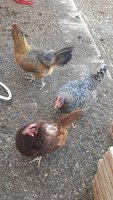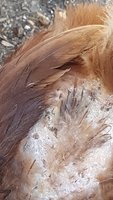- Apr 8, 2013
- 28
- 12
- 84


 greetings and thanks in advance for all advice. My mom has three hens that were hatched last November and began laying in the last month or so. She recently noticed the Rhode Island Red going bald in the saddle and tried some DE and then blue Pick No More (pic after DE). She handles the birds a great deal and sees no evidence of mites or lice. Now the Easter Egger is also looking like it’s got less saddle feathers. The only one without issue is Boomer, the Barred Rock, who seems to be top of the pecking order. We were beginning to think she was a crow less rooster but then she started laying.
greetings and thanks in advance for all advice. My mom has three hens that were hatched last November and began laying in the last month or so. She recently noticed the Rhode Island Red going bald in the saddle and tried some DE and then blue Pick No More (pic after DE). She handles the birds a great deal and sees no evidence of mites or lice. Now the Easter Egger is also looking like it’s got less saddle feathers. The only one without issue is Boomer, the Barred Rock, who seems to be top of the pecking order. We were beginning to think she was a crow less rooster but then she started laying.The birds are on all purpose food with high calcium, healthy and protein snacks (they are her babies and she makes them mixes of whole seeds, oatmeal, meal worms, and they get yogurt and a variety of fresh greens and fruit).
As Boomer’s saddle looks fine, I think she’s the culprit. Mom has seen the girls pick at their own feathers but very infrequently.
Advice would be much appreciated.



